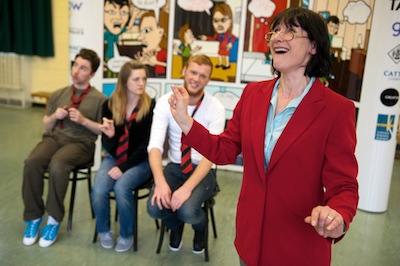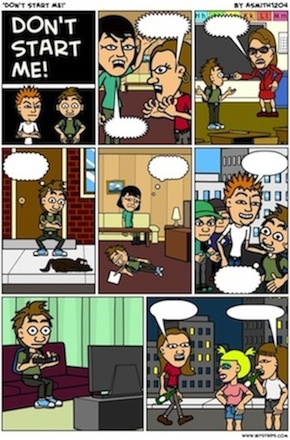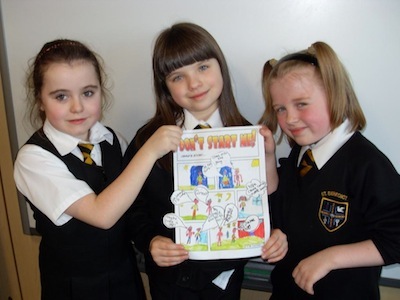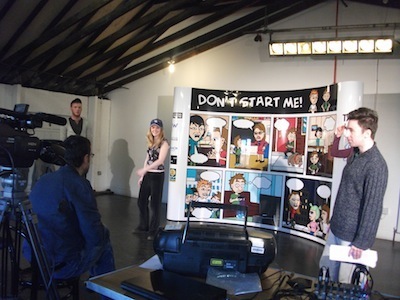About
Over a week-long, intensive period, pupils watched five online dramas (webisodes) telling the story of a fictional country in a state of emergency caused by civil conflict. The webisodes were watched at the start of the school day and stimulated debate and cross curricular activities relating to themes of war and conflict throughout the rest of the day. Schools developed their individual approach, supported by a teaching artist to help inspire their State of Emergency journey. Glow was primarily used by teachers and teaching artists to share ideas in preparation for the intensive week period. Glow was also used to host and show the webisodes. All seven schools participated in a Glow Meet at the end of the week to discuss the activities and learning they had experienced.
Click here to watch 5 minute video
The project involved:
- Visible Fictions Theatre Company
- 7 freelance artists
- 7 S2 year groups (approximately 650 pupils) and their subject teachers (approximately 70 teachers) an0d school management from 7 secondary schools;
- 7 local authorities: Argyll and Bute; East Ayrshire; Glasgow; Inverclyde; North Lanarkshire; South Lanarkshire; and West Lothian
Partners:
- British Red Cross
- British Army
- War Child
- BBC
- Scottish Refugee Council
Purpose
The project aimed to:
- Connect teachers and artists to explore, deliver and evaluate new approaches to delivering subjects with S2 pupils through Glow:
- Create of a dynamic and innovative on-line arts education resource for teachers and pupils which will remain with the local authority as a legacy for future work
- Embed CfE in every component of the project
- Nurture inter-disciplinary work
- Explore new ways of using Glow within classrooms by pushing artistic boundaries and creative processes
Curriculum Areas
- Expressive Arts
- Health and Wellbeing
- Numeracy
- Literacy
- Social Studies
- Sciences
- Technologies
- Religious and Moral Education
Levels and Stages
S2 year group
Types of Learning
Active
Task based
Inter-disciplinary
Project Activity
‘The webisodes gave a focus for a number of projects that were developed ‘in-house’. This created a unique opportunity to work with S2 pupils over an extended period. They were all fully engaged and contributing well to lessons. They could see the link between subjects and the last day activities brought all they had learned throughout the week to a conclusion’.
Teacher, Glow survey
In November 2010 the entire S2 year group in the seven schools came off the normal timetable for one week and took part in ‘State of Emergency’. This project created a virtual world through four online dramas (webisodes) which documented the lives of a group of teenagers caught up in civil conflict. The pupils were asked to become involved in the decisions and dilemmas faced by the characters to better understand the consequences of war.
In preparation for the intensive week school teaching staff were supported by a team of Visible Fictions teaching artists to create resources through the Glow network, linking up with other schools across Scotland. The project encouraged teachers to creatively enhance all curricular areas and Visible Fictions supported them to find the right approach for their subject and explore how it could link with other curricular areas through the themes of war and conflict. This structure means the skills developed during the project will remain within the schools with the prospect of the project being delivered by the staff teams for the years to come. Examples of classes were:
- a Home Economics department in one school working alongside a local organic farmer to explore what food could be grown if the area was cut off from the rest of the world and then cooking from a ration bag;
- the Maths department in one school exploring volume and weight through a dynamic exercise that asked pupils to think about what they needed in the event of fleeing their home land – packing a bag full of essentials to survive an emergency situation;
- a Science department teaching water filtration by sourcing water from the local burn and using a pair of tights to make it suitable for drinking;
- PE staff using role play techniques to explore Democracy and Regime;
- a Computer Studies department allowing the school internet system to be taken over by the underground newspaper;
- the Technical department in one school worked with a survival expert to explore shelter and fire building in the local woods and the army setting up an outdoor assault course;
- critically analysing war art and photography from different periods and discussing the emotions the art provoked;
- role play exercises, with groups of pupils becoming aid workers/ refugees/ press corps/ army personnel/ besieged – within each role pupils participated in a variety of activities designed to enhance their understanding of the reality of life for people caught up in a state of emergency; and
- talks and workshops with a range of external agencies and partners, including the Red Cross, Scottish Refugee Council, the Army, a human rights lawyer.
Planning and development
Teachers, or Head Teachers, were involved extensively in planning how the project would look and work in their particular school and within their subject area; developing activities and resources to be used during the intensive week; and finally, delivering the project. The input in terms of planning time for teachers was quite extensive, representing between 11-20 hours for most teachers, although less for others. In a number of schools, teachers from all subject areas involved met together to do the planning along with senior management; in one school, the Head Teacher was the main person involved in planning activities with the teaching artist and with Visible Fictions – this resulted in subject teachers at the school feeling detached from the planning process. Teachers were guided throughout this process by a teaching artist, assigned to each of the seven schools – their role was to support teachers to think of creative, innovative and active activities for pupils to take part in which covered and cut across each area of the curriculum.
Pupils were not involved at all in planning, and to a very minimal extent in project delivery – this was crucial to the success of the project, to build suspense and excitement amongst pupils and keep them guessing about what every day would bring.
As a result of how the project was planned, there was significant variation between schools in terms of how ‘‘State of Emergency’ was implemented within their school – some kept time-tabled subjects, but ensured each addressed or related to war and conflict-related themes; other schools came completely off-timetable for the whole week and had a very active, fluid week of activities related to the project’s themes. Schools were encouraged to communicate with each other throughout the planning process, via Glow, to share ideas and resources for different subject areas.
How was Glow used?
‘State of Emergency’ used Glow in the following ways:
- to host and show the webisode dramas;
- teaching artists and school teachers posted ideas for class activities and resources they had developed on the project Glow group to share with other schools;
- some use of the discussion forum by schools to share experience and update other schools and Visible Fictions on progress in terms of project planning;
- evaluation surveys conducted using Glow; and
- a Glow Meet between the seven schools on the final day of the intensive week when pupils from each school shared their learning and experiences.
‘I used Glow to look at different schools and what their plans were for State of Emergency and how they had responded to it. As staff in HC created their own lessons and put them on Glow I was able to work with some of the ideas to help create my lessons. Some issues were resolved by software issues in the authority and we now have a template for what is required in a glow computer so that all areas can be used. Getting into the site on a regular basis made me feel more comfortable with it, by finding a few hints and shortcuts it made me use it more’.
Teacher, Holy Cross
Impacts
An independent evaluation was carried out by Blake Stevenson. Their research shows that the project had the following impacts:
New skills, knowledge and approaches for teachers
‘I was perhaps the most negative of all the members of the English department about the State of Emergency project; however, the pupils themselves have completely changed my mind. Their conduct and attitude over the course of the week has been phenomenal and the work they have produced is outstanding. They have truly blown me away!’
Teacher, Clyde Valley High
The majority of teachers involved in the evaluation found ‘State of Emergency’ to be a ‘very useful’ teaching resource; only one teacher said that they had not found the approach to be useful. The majority of teachers also felt that ‘State of Emergency’ had had quite an impact in terms of improving pupils’ engagement with classroom activities; some felt the impact was significant.
For all teachers, using the dramas portrayed in the webisodes as a basis to drive curriculum activity for a week was a completely new approach to learning and teaching activity. Although one teacher felt things could have been improved by some live interaction with the actors playing each of the characters. Teachers felt the webisodes were of very high quality and that they offered a unique focus for the week, exploring a range of interesting and inter-disciplinary issues which allowed teachers to plan and link related activity across all subjects of the curriculum resulting, in some cases, in a truly inter-disciplinary learning experience (to varying extents in each school).
Other approaches such as taking a whole year group off-timetable to such an extent represented new approaches to teaching for some schools; others said they had come off time-table before for whole year group activities, but that this had not been on as ambitious a scale as with ‘State of Emergency’. One teacher commented that having the whole year group working so closely together for a full week helped pupils learn a lot about each other, including each other’s strengths and weaknesses and how best to work together. While many schools had used some form of active learning/task-based approach to teaching in the past, this had not previously been done to the extent managed during ‘State of Emergency’ week.
A few teachers said the project represented a new approach to working in partnership with arts organisations, artists and other external bodies, which felt more collaborative and creative. Schools felt having a dedicated teaching artist to support all their project planning and delivery gave them confidence to realise their ideas and be more creative – there was a sense that the teaching artists were able to inspire teachers and also to encourage them to be more ambitious in their plans. One teacher commented that the project had made teachers in the school realise how innovative they could be and that the teaching artists had helped generate ideas and let the teachers take them forwards.
All teachers felt ‘State of Emergency’ absolutely embodied a CfE approach and had therefore made a contribution towards their school’s approach to CfE. Some teachers felt that the project had demonstrated the extent to which inter-disciplinary working is possible within schools and would make them think about further inter-disciplinary opportunities in future.
New skills and knowledge acquisition for pupils
‘Many of the pupils talked about other lessons and activities. They also commented on their relevance to the theme. Some realised that in a real SoE things would be very different. The science water purification was treated with far more seriousness as the students could see the relevance, as was the creation of a protest song and the repeating of the scenes for videoing’.
Teacher, Cumnock Academy
All teachers consulted felt ‘State of Emergency’ had had a positive impact on pupils’ learning experiences, and had opened them up to new types of learning experiences. Teachers also said that the project had demonstrated to pupils how fun and interesting learning can be.
A number of schools noted a small increase in attendance, improvements in behaviour and reductions in punitive exercises carried out during the intensive week period because, as one teacher put it, “pupils were busy and engaged with new stimuli to motivate and enthuse them”.
The project promoted the following key learning:
- highly inter-disciplinary learning linked by the themes of war and conflict;
- debating and discussing issues related to war and conflict;
- knowledge about the role of different organisations and professions in conflict situations.
Pupils’ participation in ‘‘State of Emergency’ ’ supported them to develop the following new skills and knowledge, much of which would be helpful to them in the future, particularly in terms of helping them think about career paths they might follow:
- decision-making and problem-solving skills because a number of tasks require them to make quick decisions in response to mock conflict situations;
- respect for other people, no matter where they come from;
- how lawyers are involved in promoting and protecting human rights;
- “there’s more to the army than just fighting” – discipline and working as a team; and
- prioritisation skills.
Pupils felt the Co-Create project had helped them think about a number of things very differently and also about things they had not thought about before, such as:
- how comfortable their life is and how this contrasts with others who face more hardship;
- how some people struggle to meet their basic needs when they have luxuries like X box game consoles;
- what their personal priorities are in life; and
- whether there is ever a legitimate case for war.
The project also helped pupils develop their presentation skills and confidence in presenting, as during the week they had to make presentations to small groups, to the rest of the school, and to the other participating schools via Glow Meet. Teachers also felt the project had been successful at promoting leadership skills amongst pupils due to the many opportunities for different pupils to lead different groups and activities and be supportive of others.
Pupils described the week as mentally and physically challenging. They would all like to participate in something like this again, primarily because of the physical and active learning the project promoted.
The project enabled pupils to learn in a very active, task-based and inter-disciplinary way which the majority engaged very well with. It was also highly effective in promoting independent thought and debate around significant issues related to war and conflict.
The project supported a greater appreciation for how curricular subjects interact and crossover and the relevance of each. It contributed significantly to all of the capacity areas:
- Successful Learners – as a result of increased engagement and motivation for learning due to the active and task-based nature of project activities;
- Confident Individuals and Effective Contributors: debate and discussion, as well as presentation were activities and skills promoted throughout the week, helping pupils to be more confident, effective contributors; and
- Responsible Citizens – the issues of war and conflict gave pupils an understanding and appreciation for how life is elsewhere in the world, supporting them to be more responsible citizens.
New skills and knowledge for Visible Fictions
As keen proponents of arts based active and rich task-based learning, Visible Fictions used the Co-Create opportunity to test out their aspiration to use the arts as a way to promote and create a genuinely inter-disciplinary, exciting approach to learning, designed to actively engage all pupils, even those schools which sometimes struggle to engage. The successful completion of the Co-Create project gave them the opportunity to pilot this approach and has given them confidence to pursue similar ideas of such an ambitious scale within schools in future. The success of this project will allow them to persuade other schools to participate in similar activities.
Other outcomes for Visible Fictions include:
- greater understanding of the potential of Glow and increased enthusiasm for use, as well as better awareness of its limitations and school attitudes towards Glow;
- better understanding of the complexity of timetabling issues and the planning and thinking required by schools to enact a project such as ‘State of Emergency’ ;
- recognising that schools have to drive and have ownership of initiatives such as ‘State of Emergency’ to ensure success;
- greater appreciation of needs of school to risk assess and to pin down and plan out where each pupil is at all times when doing something so different to usual; and
- planning, preparation and a good lead in time are crucial.
Challenges and Learning
Visible Fictions experienced the following main challenges in delivering ‘State of Emergency’:
- the IT support and capability (in terms of broadband) available to schools at Local Authority level affected the effective functionality of Glow;
- negativity and lack of enthusiasm by teachers to use Glow; as a result most of the shared ideas and resources posted on Glow were put up by teaching artists, rather than by the teachers as intended
- due to delays in production, the webisodes were only made available to schools a week before they were shown (although scripts were provided earlier than this)– this made some teachers anxious as they would have preferred longer to familiarise themselves with the material and plan their resources and classes accordingly;
- struggling to convince all schools to come off timetable for the whole week and buy completely into the ethos of the project; and
- constant negotiation with schools to allow time and space for teacher steering groups to come together. When teachers were allowed the time to collaborate effectively, planning progressed quickly, however outside these meetings, some teachers struggled to find the time to dedicate to the project. This was resolved by arranging in-service days at the schools throughout the project and getting the teaching artist to liaise with their school to ensure agreed tasks were completed.
Key learning
Learning from the above, future delivery of the same or a similar project would include:
- being more realistic about school ability and capacity to use Glow, allowing more time at the beginning to support teachers to be confident users of Glow;
- convincing schools of the benefits of having a teachers’ steering group to co-ordinate project planning and activity, supported by in-service support days; and
- enabling schools to see the webisodes further in advance
Other
Generally teachers, teaching artists and Visible Fictions were in agreement that the partnership model adopted by the project was effective. Having a teaching artist in each school meant each school had tailored support and a key person to contact; it also meant schools could adapt the ‘State of Emergency’ approach to best meet the need of the school and pupils and build on the strengths and resources locally.
Funding
Co-Create was funded through a partnership between Learning and Teaching Scotland and Creative Scotland’s National Lottery Fund.
For more information contact:
Paul Gorman, Head of Education and Participation paul@visiblefictions.co.uk
Or visit:
















 ABOUT
ABOUT









